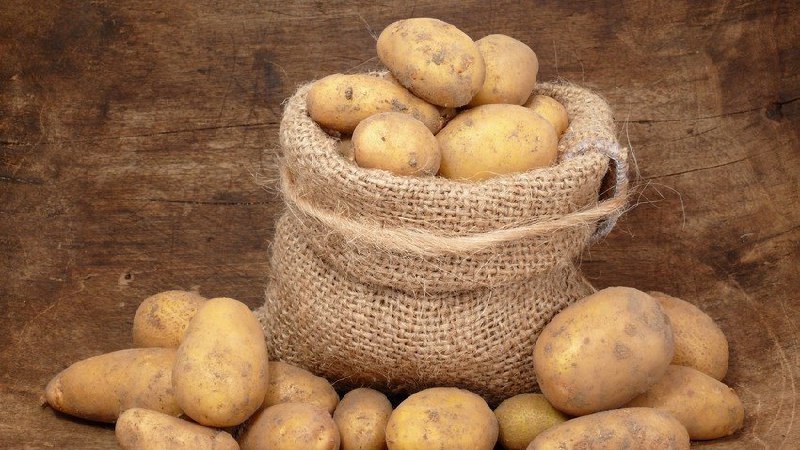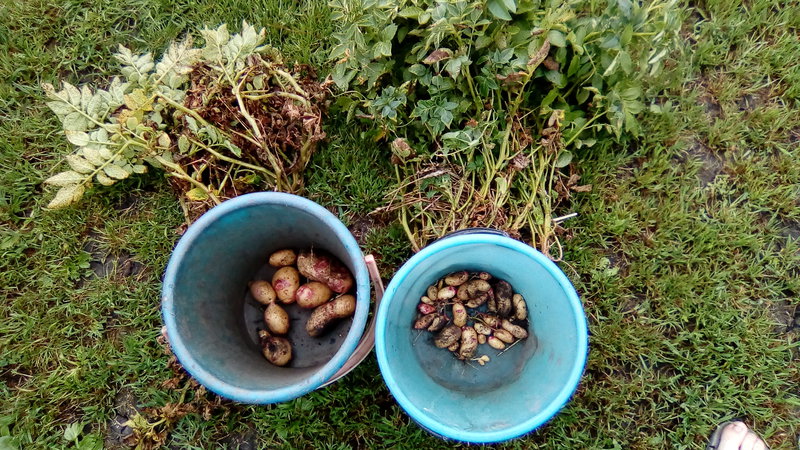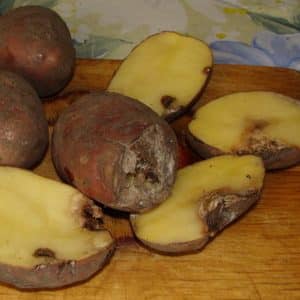Features of storing potatoes: at what temperature do they freeze?
The maximum task of every summer resident is preserve the harvest from the garden until spring. Potatoes tolerate long-term storage better than many other vegetables. Under suitable conditions, the tubers are kept in perfect condition and remain suitable for consumption until spring.
In this article we will tell you how store tubers correctly and will potatoes freeze at minus 5 degrees.
Necessary conditions for storing potatoes
To ensure that potatoes retain their taste and do not become limp and wrinkled, they are stored in a ventilated room with certain humidity and temperature parameters.
Important! To increase your chances of saving the harvest, choose the right time for digging. The longer the tubers remain in the soil, the better they ripen and are stored. But this rule only applies in stable dry weather and before frost sets in.

Temperature
Experienced summer residents recommend storing crops at temperatures from +1...+3°С. Drops below 0°C and sudden fluctuations are not allowed. If the storage temperature rises, the potatoes will begin to sprout and quickly become soft and unfit for consumption.
As the levels drop, the starch in the potatoes will begin to turn into sugar. For this reason, sometimes potatoes with a sweetish taste appear on the table.
Now let’s answer the question, at what degrees do potatoes freeze?If the thermometer drops below –2°C, the vegetables freeze completely and are not recommended to be eaten.
Important! Basement or cellar - optimal places for storage, since potatoes require not only optimal temperature, but also a special light regime. When tubers are exposed to light for a long time, solanine is formed in them - a component harmful to human health, due to which the vegetable acquires a greenish tint.
Humidity
Potatoes spoil quickly in high humidity, which increases due to lack of ventilation. If it is not possible to provide good ventilation in the cellar, it is better to store potatoes in the garage.
When humidity rises, gardeners are forced to fight rot and fungal diseases, and the harvest can rarely be preserved until spring.
Optimal values for potatoes are 75-80% humidity. In such conditions, tubers retain all vitamins, microelements and taste.
Preparing potatoes for storage

Ideally, the crop needs a preparatory period and gradual adaptation to temperature conditions. During the month before placing tubers in the cellar potatoes are kept in storage, lowering the temperature daily by 0.5°C. However, such conditions are achieved only in specialized vegetable storage facilities, where everything is monitored by an automatic system.
In ordinary cellars and basements, by the time the vegetables are planted, a suitable temperature has already been established - from +2 to +4°C. It takes 2-3 weeks. By this time, physiological and biochemical processes in the tubers have ceased - this means that they are completely ready for storage.
Activities to prepare potatoes for wintering:
- manual cleaning of soil residues and stuck lumps;
- drying - potatoes are laid out after digging in one layer outdoors under a canopy or in a dry, well-ventilated room without access to sunlight;
- sorting - diseased, rotten, insect- or shovel-damaged specimens are removed.
Specimens that were damaged when dug up with garden tools can be left for 10-12 days in a dry room. If the cuts on the tubers remain dry and no rot appears, the vegetables can be stored along with the rest of the harvest.
Attention! Do not wash potatoes before loading them into the cellar. It will accumulate excess moisture and quickly rot.
Preparing the room and container
Potato storage must be prepared in advance. The cellar is protected from freezing and any contact with the external environment. If possible, a small superstructure is built above it.
The hatch is insulated with foam plastic or another heat-insulating layer; the entrance must be hermetically sealed. If the room is deep, an additional air layer will be installed above the first hatch to protect against the cold.
Important! To protect against moisture, containers filled with quicklime or other moisture-absorbing compounds are placed in the corners of the cellar.
The cellar is ventilated before storing vegetables and treated for parasites and fungi. Disinfect with sulfur bombs or lime whitewash.
Suitable containers or bins are prepared for potatoes. It is not allowed to store tubers in bulk on the floor. Wooden stands 15 cm high are built for the boxes. The sides of the containers must have holes to provide ventilation.
Apartment owners who do not have cellars place potatoes on balconies: in boxes on wooden stands. Vegetables should not come into contact with cold floors or walls.
When it gets cold, use:
- blankets;
- blankets;
- old warm clothes;
- burlap.
The room must be closed and regularly ventilated. Loggias without glazing are not suitable as vegetable storage facilities in cold regions. In cities where the temperature in winter does not drop below 0°C, summer residents build pallets or boxes and store the harvest in bags on their balconies.
How to prevent potatoes from freezing
In cellars that are too cold, special split systems are installed to avoid a sharp drop in temperature. This requires additional costs, so some gardeners replace them with compressors from old ones. refrigerators.
The sensor will help prevent temperature fluctuations. Potatoes will be protected from negative temperatures by lamps placed in the corners of the basement. So that they serve exclusively as heating devices, they are coated with red or other dark varnish.
Insulation materials will help protect the crop from freezing:
- straw;
- felt;
- sawdust;
- sackcloth.
These coatings do not obstruct the passage of air, so the potatoes do not rot.

What temperature should be maintained?
The most suitable range is from +1 to +4°C. In warm weather, vegetables sprout quickly. Gardeners recommend sprinkling beets on top of the potato layer. It absorbs excess moisture well and protects against cold weather.
For sufficient air ventilation, folded layers should not be higher than 1.5 m.
Temperature specifications for potatoes
Short-term storage of potatoes at temperatures above 15°C is permissible for 10-14 days at high air humidity (not dampness). The main condition is placement in a dark place.
Sharp temperature fluctuations lead to the germination of eyes and the appearance of roots.
Experienced summer residents take into account the characteristics of the soil in the area where the cellar is located:
- dense soil releases heat faster, so in summer there is a risk of overheating of stored products, and in winter there is a risk of freezing;
- clay soil is characterized by high thermal conductivity; when equipping basements, reliable thermal insulation materials are used;
- sandy and dry lands warm up and freeze faster than others;
- in sandy loam soils, do not make cellars that are too deep to avoid freezing of food.

What to do if the temperature at the storage location drops below 0°C
The freezing temperature of potatoes is about –2…–3°С. At such values, starch is converted into sugar, and the taste of the crop deteriorates. To the question at what temperature do potatoes finally freeze, the answer is this: if the thermometer drops even lower, all the useful elements and vitamins in the vegetables are destroyed, the product finally deteriorates and becomes unfit for consumption.
Seed material is stored only at +3°C, otherwise the components that activate the growing season die.
Important! Late-ripening varieties are more resistant to low temperatures and can withstand long-term storage until spring. Early varieties completely lose their taste in winter.
On open balconies, polystyrene boxes with walls at least 5 cm thick are used for insulation. Such boxes with sealed lids serve as a thermos; they are regularly ventilated by covering the vegetables with a warm blanket.
What to do with frozen potatoes

How many degrees of frost can potatoes withstand in the ground? If the potatoes managed to freeze in the ground due to the first frost (down to -4°C), but did not stay in the soil for more than 14 hours, they are dug up as quickly as possible.
Before storage, vegetables are dried in a ventilated area. Periodically, the bins are inspected for spoiled specimens. But you cannot constantly mix the laid layers.
Lowering the temperature to -10°C is dangerous for the crop - it is disposed of, since it will completely rot during storage. The product is not used in cooking; the formation of toxic substances begins inside the tubers.
Conclusion
Although potatoes are one of the most unpretentious and cold-resistant crops, they require stable humidity and temperature during storage and react negatively to dampness and sudden changes in thermometer values.
By equipping a cellar, basement or balcony with suitable storage boxes and using thermal insulation materials, you can save your harvest until spring.